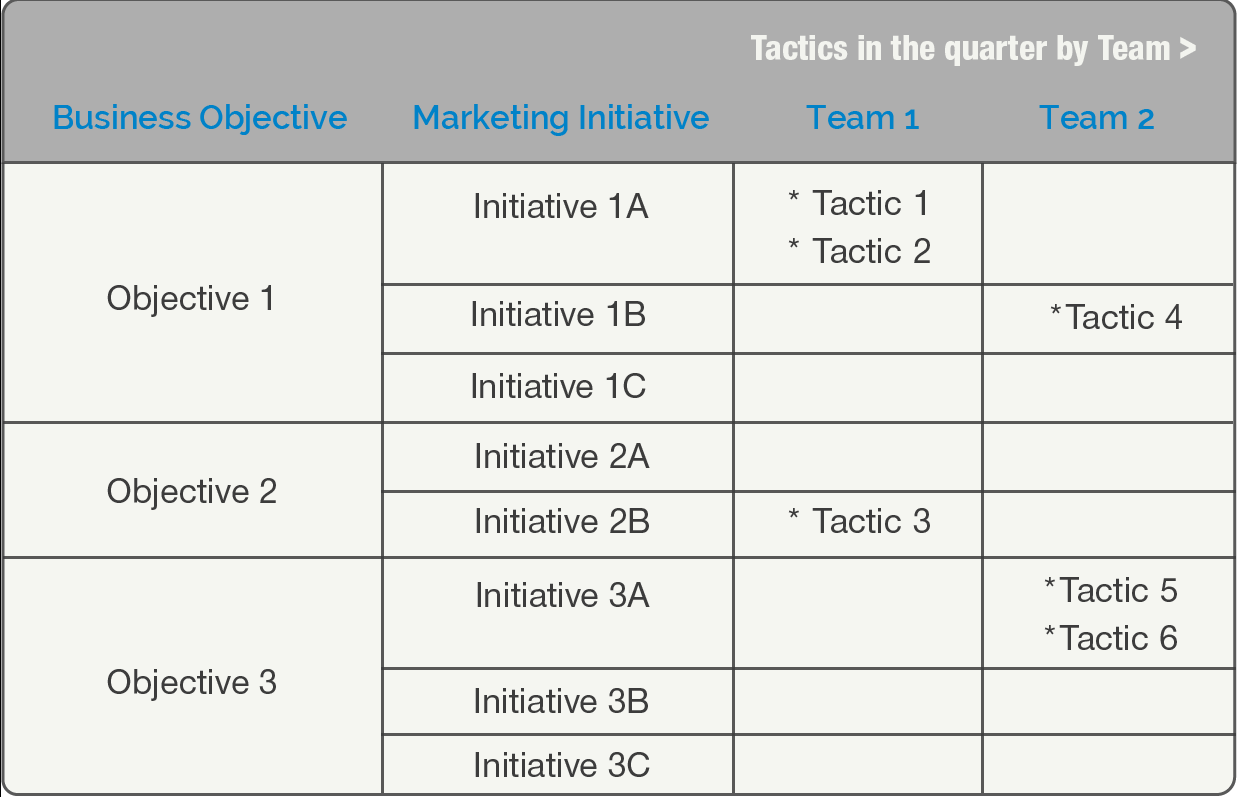In a previous blog post, Creating a Marketing Plan That Won’t Die a Slow, Miserable Death, we looked into how to go about planning for an upcoming year or quarter. In this post, we will focus on how to bring all these planning efforts into reality through day-to-day activities. Many companies miss this crucial step. Their good plans sit on the shelf (or the server) untouched, becoming the major reason why most planning exercises go to waste.
year or quarter. In this post, we will focus on how to bring all these planning efforts into reality through day-to-day activities. Many companies miss this crucial step. Their good plans sit on the shelf (or the server) untouched, becoming the major reason why most planning exercises go to waste.
To recap from the previous blog:
- Step one: Your executive team has identified business objectives for the upcoming year or quarter.
- Step two: Marketing leadership has come up with marketing initiatives that drive towards each business objective.
Now we have to finalize the third component of the planning and operationalizing process – the actual tactics. Here’s how we differentiate the three components:
Business objectives: What do you want to get done?
Marketing initiatives: How are you going to do it?
Marketing tactics: What exactly are you going to do?
Thus, tactics are the marketing programs that will bring the broadly defined marketing initiatives to life. Examples of tactics include:
- Advertising campaigns
- Email campaigns
- Promotions
- Product improvements
- Public relations
Connecting tactics with marketing initiatives and business objectives is important. That’s usually accomplished using a “tactics table.”
Tactics Tables
In preparation for the marketing planning meeting (typically scheduled at the beginning of every quarter), the head of marketing planning should distribute templates to each team lead participating in the planning meeting. As a required exercise prior to the meeting, each team has to fill in the marketing tactics that they plan to perform in the upcoming quarter towards the determined marketing initiatives.
Make a Tactics Table
Prior to the planning meeting, you should compile all these inputs into one master table. In the planning meeting, the group should discuss one marketing initiative at a time, focusing on the tactics filled in by teams for that quarter. Refine the tactics in the master table based on the following considerations:
- Combine tactics that are similar but created by different teams. Assign one team overall responsibility of the combined tactics.
- If a tactic from one team is merely a supporting activity for a tactic from another team, remove it with the understanding that teams will support each other in accomplishing the primary tactic.
- Remove any tactics that cannot be worked on in the quarter, and put them as placeholders for future quarters. (Note: tactics that span multiple quarters are totally acceptable.)
After these refinements, you should have a crisp list of tactics corresponding to each initiative, with each tactic assigned to a team that is primarily responsible for accomplishing it.
After the marketing meeting, distribute the refined tactics master table to the entire marketing group. Each marketing team member should use this tactics table to create his or her own quarterly personal objectives. This way, each team member’s personal goals are tied to those business objectives that we ultimately want to accomplish.
Agile Task Lists
The final step of translating marketing plan to day-to-day business activities is creating an agile task list. This list is the centerpiece of regular (we recommend weekly) operational meetings that help marketing executives gauge teams’ progress.
The agile task list is created and maintained by referencing the master tactics table explained earlier. Each tactic would translate to one or more of the tasks in the agile task list. Each task in the list should have the following elements at a minimum: a marketing initiative, a target date, and an owner. Here’s an example of an agile task list
The operational meetings should have representatives from all marketing teams. In the meeting, review the agile task list with emphasis on the progression of ongoing tasks and an overview of planned tasks. If a planned task has no relationship to any of the planned marketing initiatives, the meeting facilitator and participants should call it out and review its priority. This helps to make sure that everybody is rowing in the same direction, and that projects are evaluated according to whether (and how much) they will contribute to achieving the overarching business objectives.
Don’t forget to measure results
In the previous blog post, we discussed the need to identify key metrics to track progression on different marketing initiatives. These metrics should be tracked throughout the quarter so that tactics can be adjusted if the needle is not moving as expected. The “before” and “after” metric is the most powerful evidence that marketing can show, to prove the difference the team has made on specific marketing initiatives. Without this metric, all the hard work your team did can too easily be forgotten (or ignored) by the rest of the organization.
For more information on determining which metrics you should be measuring, take a look at our eBook, “The New Marketing Metrics for B2B.” This will give you an in-depth look at the new metrics you should be focused on today, including how to track the right data at the right time.
Closing Thoughts
We hope we’ve laid out a framework you can follow on planning and executing on objectives that matter to your business. We look forward to your feedback on the methodology. Do you have a different framework that works in your organization? Do you have tips or hints that can make the framework outlined here even more potent? Please share it in the comments section below!


